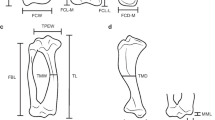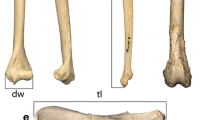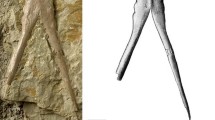Abstract
The proximal portion of a subfossil monkey femur found in a Jamaican cave shares all the femoral characters of a mature male Cebus apella.The fragment alone, however, does not prove conspecificity. The Jamaican femur is also of a size that could belong to the extinct Xenothrix mcgregoriof the same island. In contrast, the distal portion of a monkey tibia recovered from a kitchen midden in the Dominican Republic cannot be identified with that of any known living platyrrhine or catarrhine monkey. Geological age, geographic locality, and size of fragment point to probable alignment of the tibia with the recently extinct cebid Saimiri bernensis.Although no conclusive identifications are made, the distinctive characters of the two limb bones are described on the basis of comparisons with femurs and tibias representing all genera of living platyrrhines, most genera of catarrhine monkeys, and some strepsirhines.
Similar content being viewed by others
References
Fleagle, J. G., and Simons, E. L. (1983). The tibio-fibular articular surface inApidium phiomense, an Oligocene anthropoid.Nature 301: 238–239.
Ford, S. M. (1980).A Systematic Revision of the Platyrrhini Based on Features of the Postcranium, Ph.D. thesis, University of Pittsburgh, Pittsburgh.
Ford, S. M. (1986). Subfossil platyrrhine tibia (Primates: Callitrichidae) from Hispaniola: A possible further example of island gigantism.Am. J. phys. Anthropol. 70: 47–62.
Ford, S. M., and Morgan, G. M. (1986). A new ceboid femur from the late Pleistocene of Jamaica.J. Vert. Paleontol. 6: 281–289.
Goodfriend, G. A., and Mitterer, R. M. (1987). Age of the ceboid femur from Coco Ree, Jamaica.J. Vert. Paleontol. 7: 344–345.
Hershkovitz, P. (1987). The taxonomy of South American sakis, genusPithecia (Cebidae, Platyrrhini): A preliminary report and critical review with the description of a new species and subspecies.Am. J. Primatol. 12: 387–468.
MacPhee, R. D. E., and Woods, C. A. (1982). A new fossil cebine from Hispaniola.Am. J. phys. Anthropol. 58: 419–436.
Miller, G. S., Jr. (1929). Mammals eaten by Indians, owls, and Spaniards in the coast region of the Dominican RepublicSmithson. misc. Collect. 82(5): 1–16.
Rosenberger, A. L. (1979).Phytogeny, Evolution and Classification of New World Monkeys (Platyrrhini, Primates), Ph.D. thesis, City University of New York, New York.
Williams, E. C., and Koopman, K. E. (1952). West Indian fossil monkeys.Am. Mus. Novitates 1546: 1–16.
Author information
Authors and Affiliations
Rights and permissions
About this article
Cite this article
Hershkovitz, P. The subfossil monkey femur and subfossil monkey tibia of the Antilles: A review. Int J Primatol 9, 365–384 (1988). https://doi.org/10.1007/BF02737383
Received:
Revised:
Issue Date:
DOI: https://doi.org/10.1007/BF02737383




